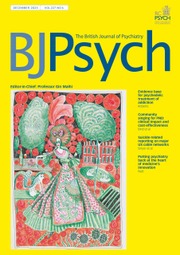France’s most famous 20th-century psychiatrist, Jacques Lacan trained with Gaëtan de Clérambault (1872–1934). Both his teacher’s ‘Psychoses of passion’ (erotomania) and his own ‘The case of Aimée, or self-punitive paranoia’ are included in John Cutting and Michael Shepherd’s The Clinical Roots of the Schizophrenia Concept: Translations of Seminal European Contributions to Schizophrenia (1987).Reference Cutting and Shepherd1 Critical of de Clérambault’s concept of ‘mechanism’ and psychiatry’s biological explanations, he emphasised subjectivity and unfulfilled desire and continued treating patients with psychoses at Hôpital Sainte-Anne until his 60s. He psychoanalysed Pablo Picasso (1881–1973).
Lacan identified as orthodox Freudian, but his objections to the biomedicalisation of psychoanalysis and the variable length of his treatment sessions threatened the expulsion of the Société Parisienne de Psychanalyse from the International Psychoanalytic Association. Lacan was expelled instead and founded the École Freudienne de Paris (EFP). Relevant, too, was his opposition to any psychoanalysis (including the then dominant Ego Psychology in the USA) that postulated an Ego that tames the Id’s alien drives in the service of social adaptation. Active in surrealist circles, Lacan always retained an interest in what cannot be completely represented or captured either within reasoned language or intersubjective recognition: the Real in his terms.
Lacan’s theoretical contribution to psychoanalysis includes: the mirror stage of development, the unconscious as language and the redesignation of Freud’s Ego, Id and Superego as the Imaginary, Real and Symbolic orders, constituting the Subject. Psychologist Henri Wallon (1879–1962) first identified a stage in development when the infant delights at the recognition of its mirror-image as a unified wholeness. Lacan argued that this serves throughout life as a powerfully seductive but brittle means of defence to survive previously overwhelming feelings of helplessness, dependency and fragmentation.
Because Lacan’s Ego is founded on an idealised external image and disavowal of troubling feelings – that is, projection – he renames it the Imaginary. He stresses a core experience of lack or absence that compels passionate desire for stable identity through intersubjective recognition. However, the mirror-image serves as a site of narcissism, aggressive identification and model for fundamental misrecognition (méconnaissance), and the subject constantly falls prey to over-identification with the other and feelings of being overpowered. He writes: ‘the ego is structured exactly like a symptom … the human symptom par excellence, the mental illness of man’.Reference Lacan2
A key to Lacan’s claim to ‘return to Freud’ was his formulation of the unconscious as language. He highlighted the crucial importance attached to processes of condensation and displacement in The Interpretation of Dreams (1900). These ‘speak’ through striking images formed, essentially, through wordplay. And what but forms of wordplay are metaphor (i.e. a word or phrase literally denoting one kind of object or idea in place of another to suggest a likeness or analogy between them, e.g. ‘sinking in sorrow’) and metonymy (i.e. the name of one thing for that of another of which it is an attribute or with which it is associated, e.g. ‘London’ for ‘the British government’)? It is via metaphor and metonymy that the Real overcomes the brittle resistance of the Imaginary ‘to speak’, not only through dreams but also jokes, parapraxes and symptoms. Hence the importance of understanding the unconscious as structured as language, not as biological mechanism.
Markedly abstract, Lacan’s diverse interests included philosophy (e.g. Hegel, Heidegger), linguistics (e.g. de Saussure), structuralism (e.g. Levi-Strauss) and mathematics (e.g. Gödel). With language we also approach the Symbolic. Here reference to Rene Magritte’s painting Ceci n’est pas une pipe (1929) reminds us that in discourse words stand in for their absent referent. In the painting there is no pipe, only its pictorial representation. It is such symbolised absence that Lacan utilised to restate Freud’s Oedipus complex in his own language. For Lacan, the Symbolic order (rules and expectations) (Superego) emerges out of the child’s anxious response to awareness of the absence of a maternal phallus. This precipitates a turn towards the father, who lays down the (letter of the) law. Specifically in psychosis, Lacan argued, there is a fundamental foreclosure and incomplete entry into the Symbolic order. Later, consistent with his surrealist roots, he returned to psychosis to explore the possibilities that might lie beyond submission to the Symbolic, through the expression of the Real.
Intense and charismatic, Lacan could be obscure, some of his followers more so. He has been criticised by many, including feminist philosopher Luce Irigaray, who was expelled from the EFP after publication of her Speculum de l’autre femme (1974). In contrast, the respectful entry in the sombre open access online Stanford Encyclopedia of Philosophy confirms him as major 20th-century intellectual, and Chris Kraus acknowledged Lacan’s influence on her seminal feminist novel I Love Dick (1997).
Culturally enormously influential but fearful that his followers might ossify his teachings into dogma, Lacan dissolved the EFP the year before his death. As we accelerate beyond post-modernism into epigenetics, neurodiversity, images, large language models (LLMs), algorithms, unsustainability and ‘too late capitalism’ and people struggle to compose themselves, his unconscious as language and Subject as unfulfilment may prove more enduringly resonant in daily lived experience than other psychoanalytic theories, perhaps than neuroscience, too.



eLetters
No eLetters have been published for this article.